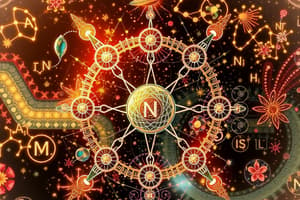Podcast
Questions and Answers
What is the role of neutrons in an atom?
What is the role of neutrons in an atom?
- Determining the element's identity
- Directly involved in chemical reactions
- Determine the atom's mass
- Stabilizing the nucleus (correct)
Which particles move around the nucleus in specific energy levels?
Which particles move around the nucleus in specific energy levels?
- Protons
- Nucleons
- Neutrons
- Electrons (correct)
What determines an atom's chemical properties and its ability to form chemical bonds?
What determines an atom's chemical properties and its ability to form chemical bonds?
- Protons
- Electron distribution (correct)
- Nucleus
- Neutrons
In the periodic table, what does the relative position of an element correspond to?
In the periodic table, what does the relative position of an element correspond to?
What is the total number of protons and neutrons in an atom's nucleus called?
What is the total number of protons and neutrons in an atom's nucleus called?
What describes the spatial arrangement of atoms around a central atom in a molecule?
What describes the spatial arrangement of atoms around a central atom in a molecule?
Which type of elements contain eight electron shells and share similar chemistry with the P-Block elements?
Which type of elements contain eight electron shells and share similar chemistry with the P-Block elements?
In which type of bond do atoms share electrons?
In which type of bond do atoms share electrons?
What is the fundamental basis for the arrangement of elements in the periodic table?
What is the fundamental basis for the arrangement of elements in the periodic table?
What are molecules formed from when atoms bond together?
What are molecules formed from when atoms bond together?
Flashcards are hidden until you start studying
Study Notes
Atoms and Molecules: Unraveling the Building Blocks of Matter
The world we see around us is made up of countless tiny particles, too small to be observed with the naked eye but fundamental to our understanding of reality. At the heart of these building blocks are atoms, the basic units of matter, and molecules, the combinations of atoms that form the substances we know. Let's delve into the intricate world of atomic structure and discover the fundamental principles that govern atoms and molecules.
Atomic Structure
Inside each atom are three types of particles.
-
Nucleus: The center of an atom, consisting of protons and neutrons, which are collectively referred to as nucleons. Protons have a positive charge and are involved in the chemical properties of an atom, while neutrons are neutral and do not participate directly in chemical reactions but do affect the mass and stability of the atom.
-
Electrons: Negatively charged particles that move around the nucleus in specific energy levels called electron shells or electron orbitals. The distribution of electrons determines an atom's chemical properties and its ability to form chemical bonds.
-
Atomic number (Z): The number of protons in an atom's nucleus, which determines the element's identity.
-
Mass number (A): The total number of protons and neutrons in an atom's nucleus, which determines an atom's mass.
The relative position of an element in the periodic table corresponds to its atomic number. For example, hydrogen has one proton in its nucleus, helium has two, and so on.
The Periodic Table and Atomic Structure
In the periodic table, elements are arranged in rows and columns based on their atomic number and the number of electron shells they have. The periodicity of chemical properties is explained by the arrangement of electron shells.
-
S-Block elements: Contain one or two electron shells. Their chemistry is relatively simple because they tend to lose or gain one or two electrons to achieve a stable electron configuration.
-
P-Block elements: Contain three to seven electron shells. Their chemistry is more complex because they can lose, gain, or share electrons to achieve a stable electron configuration.
-
D-Block elements: Contain eight electron shells and share similar chemistry with the P-Block elements.
-
F-Block elements: Contain 10 or more electron shells and are often referred to as the lanthanides and actinides.
Molecules
Molecules are formed when atoms bond together, sharing electrons to achieve stable electron configurations. Bonds form between atoms of the same element (homopolar bonds) or between atoms of different elements (heteropolar bonds). The strength of these bonds depends on the electronegativity of the atoms involved.
-
Covalent bonds: Form when atoms share electrons.
-
Ionic bonds: Form when atoms transfer electrons to achieve stable electron configurations, creating positively and negatively charged ions.
The arrangement of atoms in a molecule also affects its properties. Molecular geometry describes the spatial arrangement of atoms around a central atom in a molecule and is crucial to understanding a molecule's properties and reactivity.
As we continue to delve deeper into the mysteries of atoms and molecules, we uncover the fundamental principles that govern our world and the universe beyond. With this basic understanding, students of chemistry can explore the vast array of chemical reactions and compounds that make up our world, and begin to revolutionize our understanding of the natural world. Atomic Structure - Chemical and Engineering News, American Chemical Society. [https://cen.acs.org/educational-resources/content/atoms-molecules/atomic-structure] Periodic Table - Chemical and Engineering News, American Chemical Society. [https://cen.acs.org/educational-resources/content/atoms-molecules/periodic-table] Molecules - Chemical and Engineering News, American Chemical Society. [https://cen.acs.org/educational-resources/content/atoms-molecules/molecules] Chemical Bonds - Chemical and Engineering News, American Chemical Society. [https://cen.acs.org/educational-resources/content/atoms-molecules/chemical-bonds] Molecular Geometry - Chemical and Engineering News, American Chemical Society. [https://cen.acs.org/educational-resources/content/atoms-molecules/molecular-geometry]
Studying That Suits You
Use AI to generate personalized quizzes and flashcards to suit your learning preferences.




